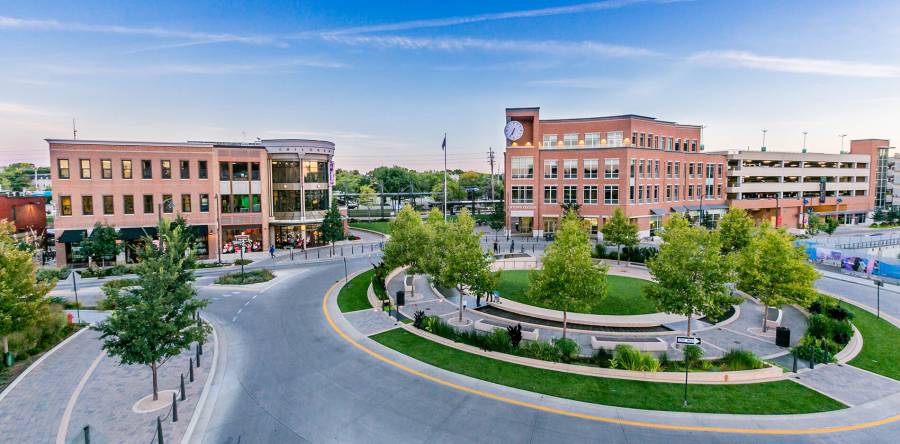Table of Contents (A) |
| Overview |
| Definition |
|
Common Substances
|
|
Education
|
|
Addiction Treatment
|
|
References
|
Overview (A):
Bloomington, Illinois, founded in 1831, is a city in McLean County and serves as the county seat. [1] Bloomington's sister city, Normal, Illinois, joins to form the Bloomington-Normal area in Illinois. From the 2020 census, Bloomington has a population of 78,680, and Normal has a population of 52,736. [2] The area is the seventh most populous community outside of the Chicago metropolitan area within Illinois. [3]
 |
| Uptown Normal |
Definition (C):
Substance Addiction is defined as a psychiatric disorder signified by the recurring desire for an individual to continue taking a substance despite harmful consequences. This differs from behavioral addictions, which do not have a critical physical item stemming as the root of the addiction. [4] Substance addiction is primarily caused by stimulation from the substances' effects when the brain becomes dependent on the euphoria and excess dopamine caused by taking the substance.
Substance Addiction and abuse is an ever-growing issue within the nation as well as the local community of Bloomington-Normal, Illinois.
Common Substances (A):
While substance addiction has a constant definition, it can take different forms, which are determined by the actual substance that is being used. Some substances are more addictive than others and will have a higher chance of an abuser becoming addicted. In contrast, some substances are easier to come by and hold fewer legal consequences, which in turn give a more significant, more prominent number of people with a substance use disorder.
Alcohol (A):
Alcohol addiction, better known as alcoholism, is a substance addiction where the affected individual continues to have repeated urges to consume alcohol regardless of any potential harmful consequences. This is primarily in the form of an alcoholic beverage. In the state of Illinois, products containing alcohol are legal to be purchased by all individuals who are age 21 or older. [5]
In the year 2016, the percentage of McLean County adults at risk for acute/binge drinking was 26.9, which is higher than the percentage at risk for the state (21.8 percent). [6] McLean County in 2016 had an adjusted emergency room visit rate of 50.7 per 10,000 residents due to alcohol abuse. [6] In 2022, emergency room rates per 10,000 residents have been reduced by 2.9 (5.7%), whereas the rate of emergency visits due to alcohol abuse for Bloomington-Normal is at 107.4 per 10,000 citizens. [7]
Resources (A):
There are options of rehabilitation and treatment available to residents of Bloomington-Normal. The agencies of Chestnut Health, Project Oz, and Alcoholics anonymous exist and operate for the purpose of providing local resources to the community. There are many other options, local newspapers, podcasts, and school programs all provide as resources within the area for the local population. A local podcast titled, Alcoholism in Bloomington-Normal features the topic.
 |
| Alcohol - Stock Images |
Opioids (C):
Opioids are a class of drugs that derive from natural substances found in the opium poppy plant. Opioids are generally used as painkillers and can become highly addictive to the brain due to this nature. Some of the most common Opioids are heroin and fentanyl. In 2022, Bloomington-Normal saw 5.8 emergency room visits per 10,000 population due to opioid use. [7] In 2021, McLean County saw 17 opioid-related deaths, which puts the county at 9.9 deaths per 100,000 population of residents. [8]
Opioids are causing a nationwide epidemic, resulting in the deaths of 645,000 people from the period of 1999-2021. [9] On October 9th of 2023, the Bloomington Police Department released a statement saying that within one two-week span, there had been nine overdoses of fentanyl, which is one of the significant Opioids involved in the epidemic.
Education (C):
Within Bloomington-Normal, education for addictive substances is present during some middle and high school health classes. The Illinois Board of Education and Curriculum requires all students to take a one-semester-long health class to meet the graduation requirements for that educational institution. To provide aid and more experience with educating about substance abuse and addiction, some schools in Bloomington-Normal have cooperated with one of the local agencies within the area, Project Oz. Project Oz, as an agency, believes in the prevention and education of potential future cases of substance abuse and addiction. [11] Students are taught about what a substance addiction entails, what the commonly abused substances are, and then how to receive help and treatment.
Effects (A):
Physical effects of a substance addiction may vary solely based on the specific type of substance that is being used. However, there are typical constants of emotional and physical side effects that come with the repeated abuse of different substances. Specific side effects of a substance addiction are overwhelming compulsions to take the substance, emotional instability, potential financial loss, and change in behaviors.
Addiction Treatment (A):
There are numerous ways someone can receive treatment for a substance addiction, and the type of treatment will vary based on the kind of substance that the afflicted person is addicted to. Within Bloomington-Normal, there are multiple different options for people to obtain treatment. There are various AA meetings (otherwise known as Alcoholics Anonymous) and numerous other agencies within Bloomington-Normal.
Agencies (A):
- Chestnut Healthcare - Chestnut Health can provide people suffering from substance addictions the proper care they need. Chestnut Health is a healthcare facility that can help patients by diagnosing and treating them and providing recommendations to other facilities necessary for the person in need.
- Project Oz - Project Oz provides education on many different topics to those struggling and comprises experts and volunteers who provide the necessary tools to help rehabilitate and educate individuals. One of the main focuses of Project Oz is substance addiction and abuse, and it focuses on educating individuals on the effects of taking substances, how to identify them, and the effects of addiction. They also have a hotline and call center where people in dire need can call for support.
- PATH - PATH (Personal Assistance Telephone Help) provides people with a crisis hotline for immediate support 24/7 and also provides support and treatment for those who are undergoing a problem with substance addiction. PATH is primarily geared towards those experiencing homelessness, which is one central area where a substance addiction may take form.
 |
| Project Oz Logo |
Withdrawal (C):
Substance Withdrawal is defined as physical and mental symptoms that may occur after stopping or reducing intake of a given substance. Managing withdrawal is one of the most important things people think about when they quit taking a given substance. Rarely do people immediately and entirely stop taking a substance or quit "cold turkey." The term quitting cold turkey is said to derive from the feeling of the skin when going through withdrawal effects- usually cold and clammy. Symptoms of withdrawal can vary depending on the substance being detoxified. Still, they can but do not always include changes in appetite, changes in mood, chills or shivering, congestion, depression, paranoia, and confusion.
Rehabilitation (C):
Rehabilitation is a significant part of treating those who struggle with substance abuse and addiction. The first step of rehabilitation is treatment initiation, in which individuals seeking help seek professional help through inpatient or outpatient methods. The next step is that of early abstinence, which is when individuals on the journey of recovery may receive therapy or behavioral counseling to attempt to identify risk factors and change characteristics that lead to substance abuse and or detoxification, which is the body's method of cleansing itself of the substance being abused or that an individual is addicted to. There exist two primary methods of detoxification: "Cold-Turkey," which is when you abruptly stop the substance the body is used to, and "Tapering," in which you ease your body off of the substance by taking less and less of the substance over time. A lot of the time, pain medications can be used to help lessen the symptoms of withdrawal and to help ease the body's transition in both cases. The next step of rehabilitation is maintaining abstinence from substances; during this step, individuals focus on changing mental, emotional, and behavioral characteristics and more to lower the likelihood of a relapse. The next step includes maintaining abstinence; individuals seeking rehabilitation have to focus on staying committed to recovery and avoiding relapse; there are different ways to help aid this process, including group therapy, family counseling, peer support groups, and social encouragement. The fourth and final step in rehabilitation is advanced recovery, which includes the rebuilding of lives, addressing mental health factors and ailments, developing a healthy and sober lifestyle, and improving overall well-being. Community involvement, continued therapy, and vocality training are all critical factors to maintaining abstinence and achieving a fulfilling life.
References (C) (A):
Podcast (C):
Sources (C) (A):
[1] "Bloomington, Illinois," Wikipedia https://en.wikipedia.org/wiki/Bloomington,_Illinois Accessed 2/21/2024.
[2] "Normal, Illinois," Wikipedia https://en.wikipedia.org/wiki/Normal,_Illinois Accessed 2/21/2024.
[3] "Bloomington-Normal," Wikipedia https://en.wikipedia.org/wiki/Bloomington%E2%80%93Normal Accessed 2/21/2024.
[4] Zou Zhilling, et al, Definition of Substance and Non-substance Addiction, National Library of Medicine, no date, https://pubmed.ncbi.nlm.nih.gov/29098666/#:~:text=Substance%20addiction%20(or%20drug%20addiction,addiction%2C%20and%20mobile%20phone%20addiction. Accessed 2/21/2024.
[5] "Most frequently asked LEGAL questions," Illinois.gov, no date, https://ilcc.illinois.gov/all-faqs/faqs-legal.html, Accessed 2/25/2024 "2022 Community McLean County Health Needs Assessment (CHNA) SUMMARY REPORT"
[6] "McLean County Health Needs Assessment," McLeanCounty.gov, no date https://health.mcleancountyil.gov/DocumentCenter/View/25212/2016-McLean-County-Community-Health-Needs-Assessment-12-1-16 Accessed 2/25/2024
[7] "Chestnut Health Systems" Chestnut.org https://www.chestnut.org/Resources/5bf3a4e6-3f9c-4226-ba91-dc4a45af5556/2022%20McLean%20County%20CHNA%20Final%207-5-22.pdf Accessed 2/24/2024
[8] "Semiannual Opioid Report May 2022", Illinois.gov, May 2022 https://dph.illinois.gov/topics-services/opioids/idph-data-dashboard/semiannual-opioid-reports/opioid-report-may-2022.html Accessed 2/24/2024
[9] Chestnut Health, https://www.chestnut.org/Resources/76392133-bbc2-44a7-bf12-b3dba094d9e9/FINAL%202022%20Infographic%20Summary%20-%20McLean%20County.pdf accessed 2/20/24.
[10] https://americanaddictioncenters.org/withdrawal-timelines-treatments, Accessed 2/25/2024.
[11] "Project Oz" Project Oz, no date, https://www.projectoz.org/prevention-and-education/ Accessed 2/20/2024.
[12] VeryWellMind. "The 4 Stages of Alcohol and Drug Rehab Recovery"https://www.verywellmind.com/the-four-stages-of-alcohol-and-drug-rehab-recovery Accessed 3/6/2024.
<div> </div>


